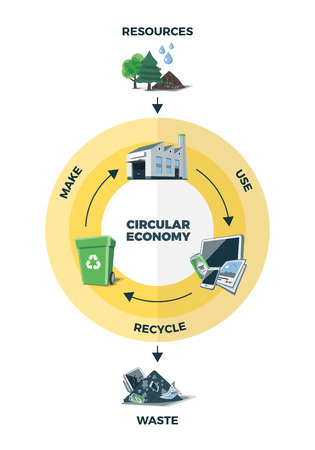If there’s one thing all businesses need to realize at the deepest level possible in the 21st century, it is that all of us only have one place to call home – Planet Earth. Given that many serious environmental problems such as global warming, climate change, loss of biodiversity, toxic pollution and natural resource depletion continue to worsen, it’s time for all of us in the business community to start thinking differently about the way we do business. Two concepts that serve as starting points are the Circular Economy and cradle-to-cradle design.
 All those environmental problems mentioned above can be attributed largely to society’s traditional economic theory and business models that view the economy as linear or what’s called take-make-dispose. We take natural resources, make things out of them, and eventually throw out the things we made when they no longer serve us. Natural systems don’t work in a linear way. Instead, nature operates as a cycle, which is why the circular economy is a much better way to frame our economic and business activities. It tries to mimic the natural cycle of life by adopting the following three principles as summarized by the Ellen MacArthur Foundation: “(1) Preserve and enhance natural capital by controlling finite stocks and balancing renewable resource flows; (2) Optimize resource yields by circulating products, components, and materials at the highest utility at all times in both technical and biological cycles; (3) Foster system effectiveness by revealing and designing out negative externalities.” If you take this concept seriously, it has all kinds of profound implications for how we do business. Because we’re a website design company, we’d like to highlight one such implication for how we should be doing design within the circular economy framework. It’s called cradle-to-cradle design.
All those environmental problems mentioned above can be attributed largely to society’s traditional economic theory and business models that view the economy as linear or what’s called take-make-dispose. We take natural resources, make things out of them, and eventually throw out the things we made when they no longer serve us. Natural systems don’t work in a linear way. Instead, nature operates as a cycle, which is why the circular economy is a much better way to frame our economic and business activities. It tries to mimic the natural cycle of life by adopting the following three principles as summarized by the Ellen MacArthur Foundation: “(1) Preserve and enhance natural capital by controlling finite stocks and balancing renewable resource flows; (2) Optimize resource yields by circulating products, components, and materials at the highest utility at all times in both technical and biological cycles; (3) Foster system effectiveness by revealing and designing out negative externalities.” If you take this concept seriously, it has all kinds of profound implications for how we do business. Because we’re a website design company, we’d like to highlight one such implication for how we should be doing design within the circular economy framework. It’s called cradle-to-cradle design.
The idea here is design things in such a way that little to no “waste” that has to be disposed. Instead, you use the “waste” for other purposes. You design a product so that if there are biological components, those can be re-used or composted and returned to the soil. If there are technological components, those are designed in such a way that they can be disassembled and re-used in the manufacture of new products or recycled. It’s important to note, however, that re-use is the focus because recycling tends to be energy-intensive and the circular economy is all about moving away from non-renewable energy sources and embracing renewable energy and conservation as much as possible. The design process framework is one where you look at every product component as a potential resource that can be used for something else.
This is fascinating stuff, right? If you’d like to learn more about these important and timely concepts, Website Design Curacao Caribbean is co-sponsoring a seminar on Wednesday April 11 beginning at 5:00 PM at the University of Curacao Caribbean (J. Irausquinplein 4 – Curacao Caribbean) on Circular Economy basics. The registration fee is USD 150 or AWG 267. Please join us to learn how businesses can participate in the Circular Economy right here on One Happy Island!

INDUSTRIES
